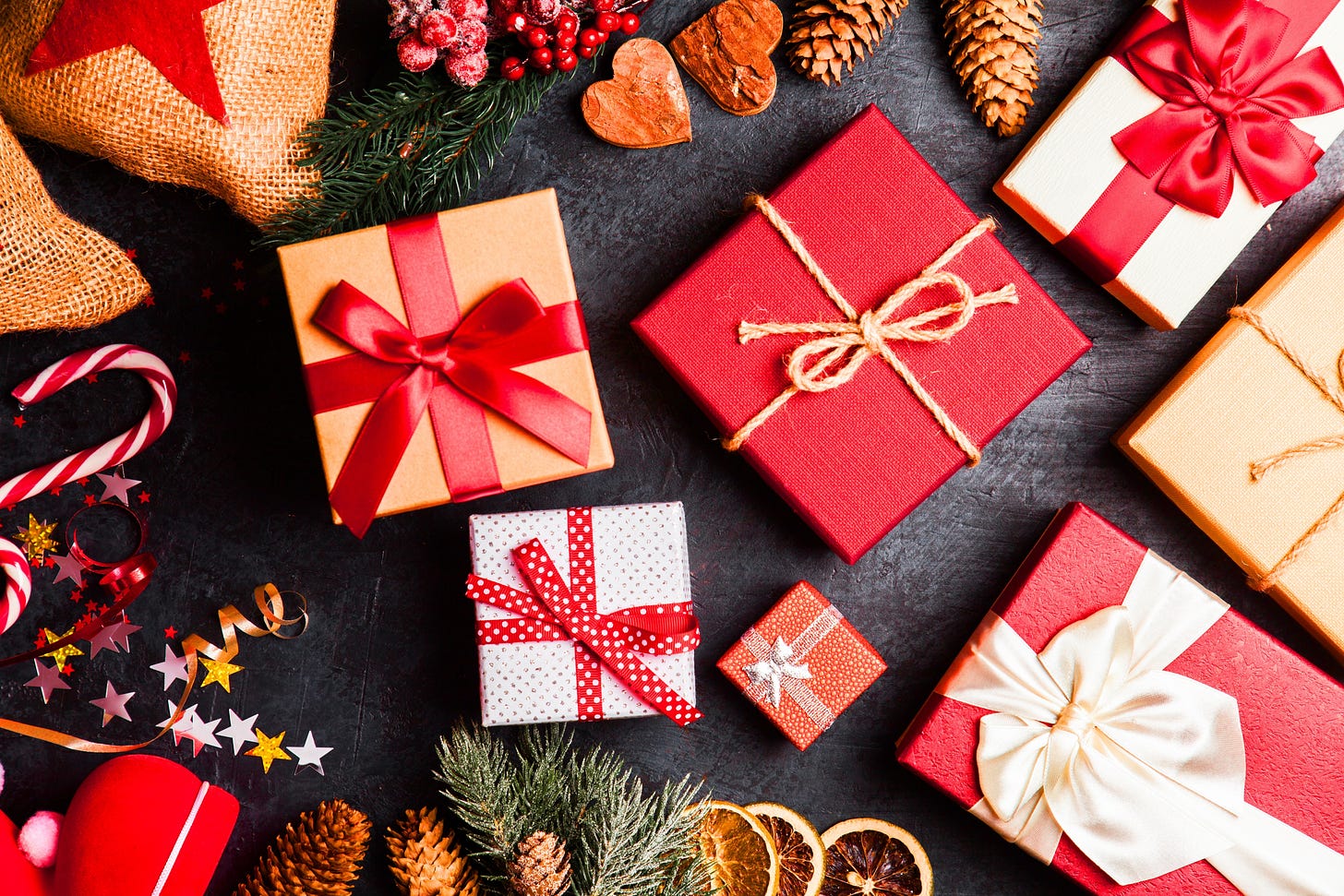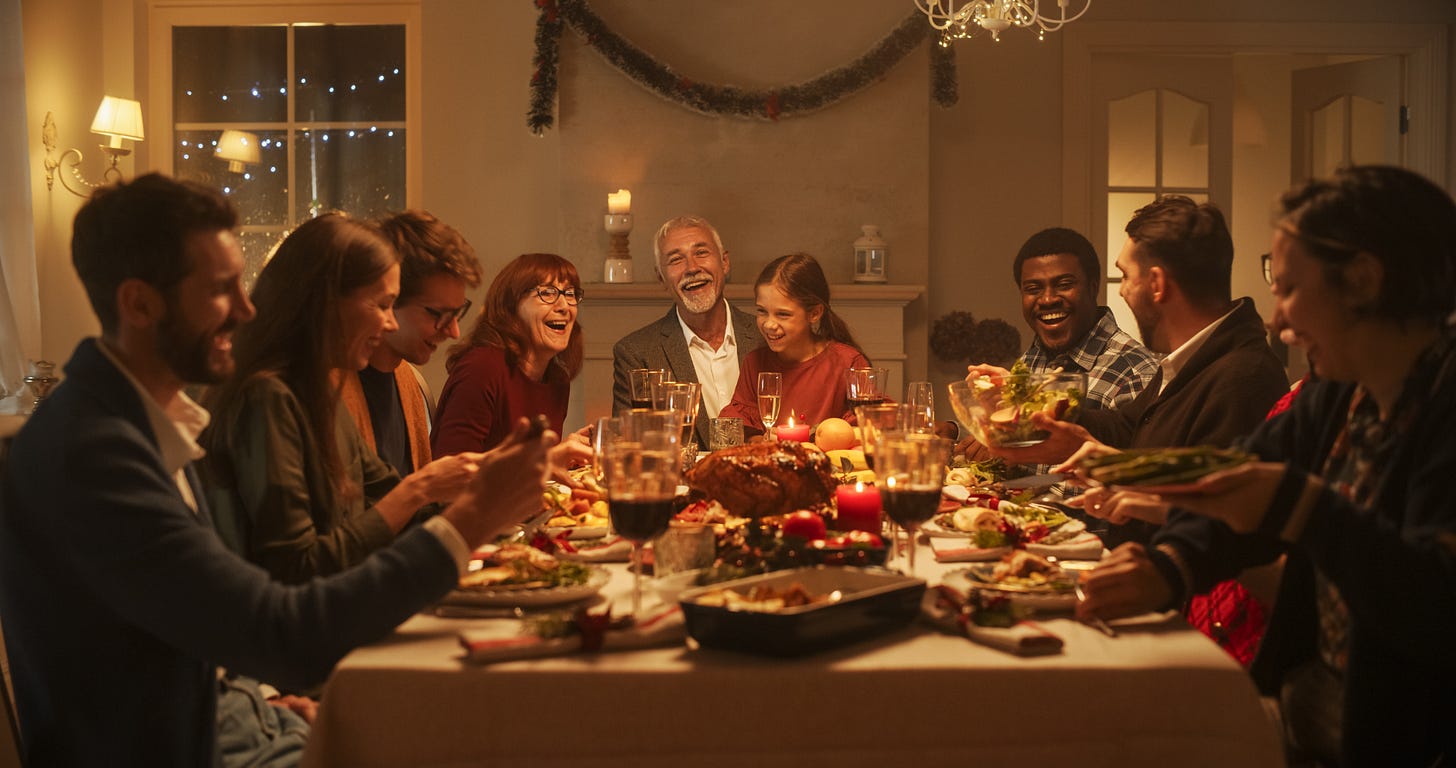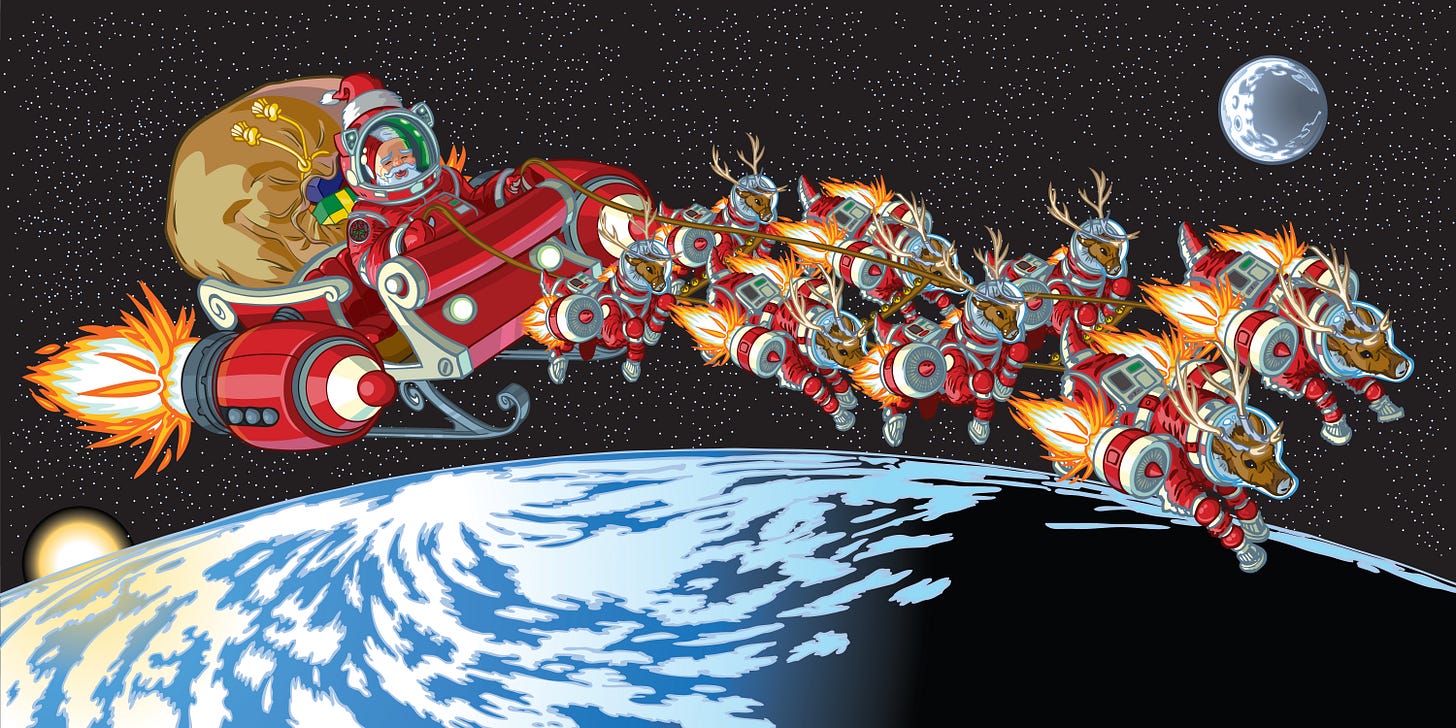Review: The Science of Christmas
A short review of the science of Christmas and the reason Santa Claus does exist, obviously
Christmas is nigh - two, or three days to go depending on which culture you live in (assuming you celebrate Christmas at all).
I am resending last year’s post with a few minor updates as it is so apt and reminder of some of the science of Christmas but also festivals and celebrations in general.
Thank you so much for being a subscriber and wishing you a wonderful festive season with plenty of the positive brain chemicals I mention below!
- Andy
The Science of Gift Giving
Let’s start off with getting presents - what else! Receiving gifts activates the reward centre in the brain - we probably can all work that out - it feels good. But Christmas is special in a good and not so good way. Why so you may ask?
Well, research into animals and dopamine levels, as a proxy for reward activation, shows us something quite interesting. First off receiving a spontaneous reward gives us a boost of dopamine. This is to be expected but what is surprising is that under certain conditions this dopamine level can be massively boosted…or decreased.
Under what conditions can dopamine be boosted?
It is under uncertainty - when the chances of receiving a reward are not certain. And the highest motivational boost is when the chances are 50/50. Just like in sports finals. The reason is multiple, but one is that dopamine can be considered as much a motivation chemical as a reward chemical in the brain (it is much more nuanced than that but I have already explored that in previous posts) and the best time to get motivated is when you have a fighting but not certain chance of getting a reward.
However, the downside is that when rewards become more certain the lower the dopamine excretion. And Christmas for most of us, has certain rewards. Ummm.
The other aspect of dopamine is related to the above and it is the aspect of expectation - wheres expected rewards may not stimulate the brain much, unexpected rewards, or above expectation, give higher activation, and those below expectation can lead to disappointment. This can all be measured in the brain, obviously.
This sounds like a bit of a conundrum for Christmas when rewards, presents, are expected not to mention the very real risk that expectations may not be met. However, the build up to Christmas builds a ritual which I will write about below - that in itself is a rewarding experience and continued expectation builds value, not to mention that for children they get much more than their daily life would enable so the chances are high that it will stimulate high reward. This is also combined with scarcity - we value things that are scarce. Christmas only comes once a year - for kids that’s a long time.
For kids getting things is important and can also affect social status - but research shows that we value experiences more than things. So gifting an experience, something that can be remembered and cherished for a long time, may be the best gift you can give.
But the clear message is still to manage expectations, and create little bit of uncertainty, and think of experiences, to create greater delight.
Primary Rewards
Another side note, and this is more of an observation, is that in research into rewards researchers distinguish between primary rewards and secondary rewards. Primary rewards are those basics that drive life forward, food, drink, and sex, for most animals. Obviously in research with animals rewards are manipulated by using particularly tasty food or drink rewards. Secondary rewards are those that come after these - money is a secondary reward but as a universal currency can buy many primary rewards.
Consuming tasty food stimulates primitive reward networks - and it is therefore no surprise that Christmas and most religious festivals and celebrations across the world involve a lot of food and drink. We naturally select primary rewards for ourselves…and also often give these to others.
Compassion and Bonding
It is rewarding receiving a present but it is also feels good to give a present. Yes, giving gifts is also a rewarding experience in itself - it is a reciprocal process and this is likely also one of the reasons that human beings are very good at giving gifts to each other. Yes, and researchers can and have measured this - we see similar patterns in the reward centre with giving a gift as when receiving a gift.
Similarly we also live through other people, something that was previously described by so-called mirror neurons. Neurons that activate to the actions of others. When we see the joy of someone receiving a gift - imagine an ecstatic child - we partly experience this ourselves - this in turn makes us feel good. So giving gifts is rewarding through the act of giving but also rewarding when we see the joy of others.
Another aspect is that in thinking through giving a gift to another person we are thinking about that person and also tying to put ourselves in their shoes to a degree. This in itself can also build connection and compassion - both of which are also rewarding experiences but more so it can trigger oxytocin our primary bonding chemical in the brain (which is also a reward chemical).
Therefore the act of giving gifts is an experience that builds bonds and brings us closer together. And it is no surprise that Christmas is indeed considered the time of bonding, as with many other festivals, of being together. Bonding is a rewarding experience in itself and this is boosted with gift giving.
So, do think through gifts and bond with others. Thoughtful gifts, however, are more likely to create bonding experiences.
Rituals
Rituals are important parts of our lives and also of many animals. In fact building rituals is also seen as an adaptive (or mis-adaptive) stress response. Though some may argue, and many will argue, that sometimes conforming to these rituals is also stressful.
However rituals create something else that is important: they create alignment and shared purpose - this in turns boosts bonding and loyalty. It is no accident that key festivals have multiple rituals, from what to do at what time, to certain typical foods, and being together in large crowds or with family and friends.
This is in general a very good things. Increased release of oxytocin, increased bonding, building relationships, and strengthening friendships. However, the downside is that for those without those close relationships Christmas is precisely the time when people can feel lost, lonely, and depressed.
I know of a church community who take it in turns over the Christmas period sharing 24-hour a day to hold watch over a tower in a forest which is known for “jumpers”, making sure to engage in conversation with any individuals who appear at risk.
That in turn is their ritual - helping others at risk over the season of goodwill.
So build rituals, enjoy them, enjoy your loved ones, and keep an eye out for those less fortunate than yourselves.
Little Sins
But some of you may counter that Christmas is all about consumption - buying unnecessary gifts and stuffing ourselves with food and drink. Yes, indeed it often is - but, as I have outlined, giving a bit of thought to gifts and rituals can make these more meaningful and manageable.
There is also probably something in our nature to feast when opportunity arises - times of plenty in our distant past may not have been often. Arguably in our current society this is not necessary. Maybe but there is also something about little sins which seem to be beneficial for health. Research into super agers show us something interesting - many of these people who live to monumental ages live simple healthy lives but what is also striking is that they also seem to have their “little sins”.
These little sins are moderate little things that are “unhealthy” a daily glass of sake for one Japanese super ager, or sweet dessert for another. It seems that the pleasure and ability to relish these moments is as much a stress reducer and pleasure inducing act that they seem to end up being beneficial. Admittedly these are little sins, hence the name, it is not continual overindulgence. So the message is yes, having a little sin and overindulging every now and again is fine, positive even. But just keep it every now and again - Christmas is after all only once a year.
Father Christmas
It is a funny thing that we need fantastical creatures, elves, gods, spirits, and magic, to explain much of our lives and these special moments. Is lying to our children really setting a good example - but isn’t this half the magic of Christmas? Precisely this magical aspect of Father Christmas is what creates the magic of Christmas - or is it? A recent piece of research came out of when children start becoming sceptical of Father Christmas (or Santa Claus depending on where you are from and family naming rituals). Around about 8 on average but with a large variance - and normally to blame are school friends or siblings.
My daughter also became quite sceptical around about this age but I quietly just told her that father Christmas exists - she got angry with me for a while with my refusal to admit anything else. This evaporated towards every Christmas when the thought of not having a stocking full of small presents was not worth the energy to fight the truth. She at 17 is now a firm believer again.
After all there is something about convergence in science. If all things point towards one thing from multiple different lines of evidence then after all it must be true. How many parents have confirmed the evidence of Father Christmas? How many cookies left out for Santa have been eaten? How many glasses of brandy downed? How many presents magically appeared? This is indeed compelling evidence. Not to mention regular articles explaining the science behind Santa Claus by illustrious science magazine New Scientist. There they explain that Rudolph’s Red Nose is probably a special material that glows red hot from the air resistance due to the enormous speeds that Santa must travel at to accomplish his mammoth task. Other explanations include quantum mechanical effects - this is solid science.
But, of course, the strongest evidence comes from Apollo 8, the first manned mission to orbit the moon over Christmas in 1968, as the crew rounded the moon and were able to re-communicate with Houston on 24th December commander Lovell signalled "Please be informed there is a Santa Claus." Now there is proof if ever there was any!
Of course you could also reply to your sceptical kids that Santa Claus is a very real symbolic concept that represents innate human desire to be generous and look after others combined with our very human ability to project ourselves through time and space which came out of the emergence of human consciousness, an ability to imagine and hence form entities and beings with very human but distinct abilities that reflect our implicit understanding of our own mortality and limitations. So Santa Clause exists as a conceptual entity that reflects innate kindness built from our higher functional cognitive abilities and as this kindness is real, and can be seen, it therefore holds true that Santa Clause is real.
And with that I wish you a very happy Christmas and festive season. Be kind, be generous, look after others, enjoy the bonding, enjoy your little sins, and be thankful for what you have as much as, or more than, what you are gifted.






